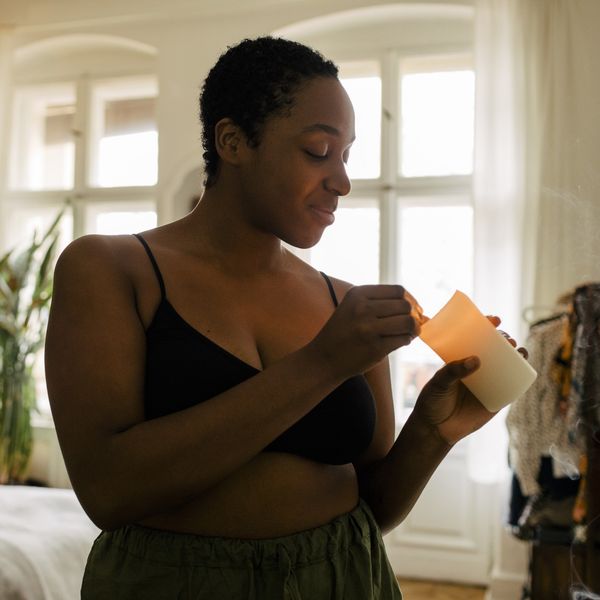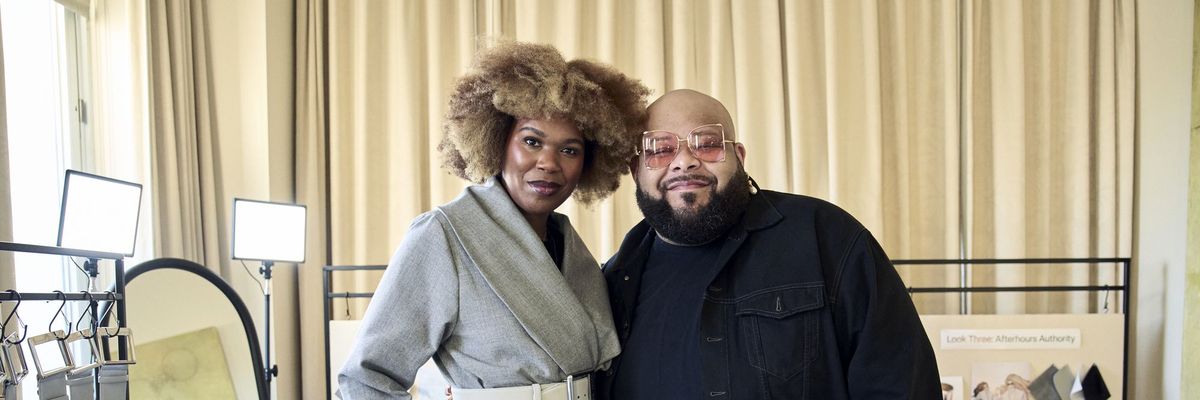Netflix's Latest Viewing Pleasure Is About Building Your Dream Sex Room

I’m one of those people who has a song in mind for almost any keyword said in a sentence. It’s a gift and curse, to my friends and my readers. Today’s song was “Sex Room” by Ludacris and however annoying it might be, I’m excited to get into it with you all. Netflix’s recently dropped a new series – How To Build a Sex Room – which is for sure the adult HGTV series I never knew I needed. But it’s so much better than any HGTV series and honestly better than anything I could’ve anticipated.
The show explores making practical sex rooms for those who will be using them. And a sex room doesn’t always mean cold, dungeon vibes. No! Instead, part of what makes the show great is that they meet people where they are and really take into account the purpose or intended use for the sex rooms, in addition to personality. You get a good variety of luxuries mixed with the feelings of home.
And while I’m not going to spoil the show, I do want to get into what and why someone might need a sex room. Maybe you want one for yourself or maybe you’re someone who passed the preview of this show and wondered, “What’s the point?” If so, keep reading.
Reasons to Consider Having a Sex Room

(L to R) Ryan, Raj, Melanie Rose in episode 102 of How To Build a Sex Room.
Courtesy of Netflix
1. Parental Control and Boundaries
Parents who co-sleep with their children may find it difficult to maintain an air of sexiness in the very room they once created their children in. Though we might say at a certain age parents should set boundaries, realistically keeping your child in their own room is not a boundary that’s always possible. That said, parents might opt for a sex room in order to rejuvenate themselves back into the seductive period of courting prior to having children. Sometimes the boundary setting is simply a matter of changing the setting and opting for privacy in other, less seemingly dismissive ways. This can be accomplished with a sex room.
2. Separation of Home and Sex
While not every sex room is dungeon-style, some are. And regardless of the aesthetic, there may be people who wish to keep their preferred kinks as private as possible. I can’t count on one hand how many times I’ve forgotten to put away my vibrator and someone walks into my home only to see it on the coffee table. And that’s a normalized part of sex…masturbation. However, imagine having someone walk into your home and you forgot to put away your flogger or box of butt plugs, and so on? The sex room helps to provide an extra layer of privacy. Not because you wish to be secretive or feel shameful, but because keeping certain parts of your life separate from others is good form as far as boundaries go. Plus, it can be really sexy to have this part of your home where only you and your lovers exist.
3. Sex, Staycation Style
The monotony of being home and having sex in the same way, in the same place can sometimes be…annoying. But also coming across safe spaces to play with your partner can be equally…annoying. Having one at home allows you to escape the day-to-day without incurring the fees associated with sex clubs. Furthermore, there’s this unspoken rule of exclusivity where you really have to know the right people in order to find kink scenes in certain cities. Having your own sex room eliminates the need for that as you create your own.

Courtesy of Netflix
4. Swinging Made Easy
If one of your kinks is swinging, a sex room might just be mandatory. Not every city has swingers clubs and in my experience when they do have swingers clubs they aren’t always diverse (age and race-wise). But having a sex room in your home allows you to host other couples consensually, thus minimizing the requirement of having to find a couple to swing with in exclusive spaces.
5. Safe Spaces and Such
For those who are into kink and wish to try out new gadgets and contraptions, I encourage you to do so safely. But hold please, because in this case, the safety I’m speaking of is more towards reading the requirements for hanging your equipment from walls and ceilings. Because this can be necessary for swings and such, some couples may opt for a sex room in an area in their house where the ceilings are more conducive to that type of sex gear – like the basement.
The bottom line is there are many reasons that people may want sex rooms. However, I think in any case it comes down to having a safe space to be able to reconnect or even connect with ourselves in ways that weren’t made possible (for whatever reason) beforehand.
If this appeals to you, you may be wondering how to create a sex room for yourself, especially after watching the Netflix series How to Build a Sex Room. Here are some ways.
- Self-Survey: Remember A.S.L via Aim? You should and if you don’t you’re far too young to be reading this article. But similar to that, you want to get a quick and dirty rundown of what you're looking for out of your sex room. So, in this case, A.S.L stands for "agenda, sex, and location."
- Agenda – What do you wish to get out of this sex room? What is your why?
- Sex – What type of sex or touch do you intend to have in this space? How do you intend to utilize this space? Is it a swinging space, or one that is just for you and bae? Do you want to explore new kinks or are you pretty airtight on the things you want to try?
- Location – Where in your home do you envision this work of art being crafted? Are we keeping it in the bedroom or do we want it somewhere covert?
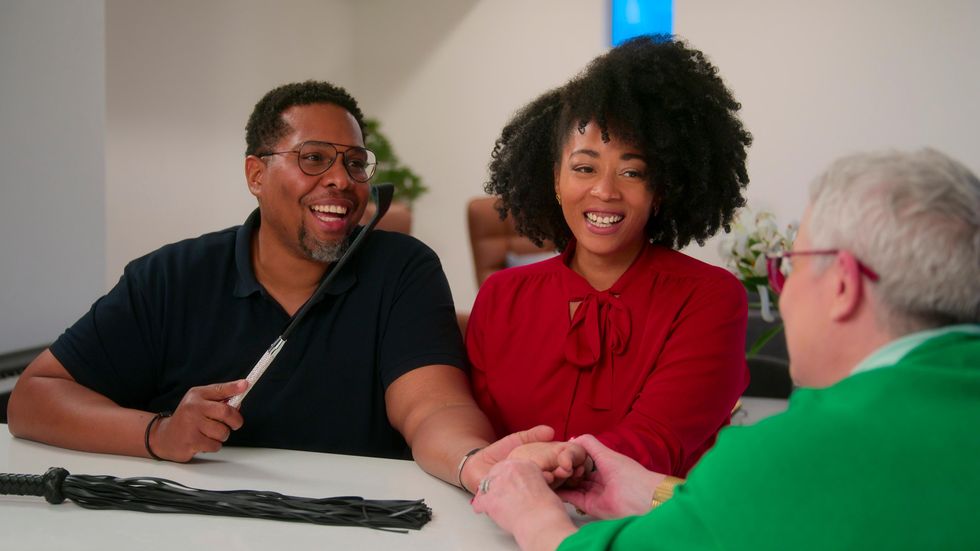
(L to R) Ryan, Raj, Melanie Rose in episode 101 of How To Build a Sex Room.
Courtesy of Netflix
- DIY or For Hire: This one is rather simple. Hmm, on second thought, if you’re someone who doesn’t understand limitations, like me, you might have a difficult time realistically gauging how to go about building your sex room. Nevertheless, you must decide if this is something you want to pull a “do it yourself” with or if it requires you to hire a contractor. Perhaps a combination of the two – it simply depends on the answers to the first two questions.
- Secret Shopper: Purchase the toys you’ll need to fill this space. However don’t get caught up like a kid at Christmas, as we want this space to be fulfilling but efficient – not cluttered. You might consider creating a list of must-haves to get you started and then creating a secondary. Wishlist.
Let’s make things inbox official! Sign up for the xoNecole newsletter for daily love, wellness, career, and exclusive content delivered straight to your inbox.
Featured image courtesy of Netflix
This Is How To Keep 'Holiday Season Stress' From Infecting Your Relationship
Hmph. Maybe it’s just me, but it seems like there is something really weird happening in the fall season air (because winter doesn’t officially begin until December 21) that cuddle season is in full swing while break-up season is as well. In fact, did you know that break-ups are so popular during the holiday season that December 11 is deemed Break-Up Day?
The reasons why relationships shift around this time vary; however, I did both roll my eyes and chuckle when I read that a very popular one is because it’s an easy way to get out of getting one’s significant other a Christmas present. SMDH.
Anyway, I personally think that the less shallow folks out here may contemplate calling things “quits” or they at least distance themselves a bit from their partner (and what I’m referring to is serious relationships) due to all of the stress and strain that oftentimes comes with the holidays whether it be financial, familial, due to their tight schedules or something else.
Listen, I would hate for you and your man to miss the fun and happiness of experiencing this time of year, all because you are so overwhelmed or irritated that you can’t really enjoy it. That’s why I have a few practical tips for how to avoid allowing the typical holiday season stress from INFECTING your relationship.
Manage Your Expectations
 Giphy
GiphyUnmanaged expectations. If there is a main reason why the holiday season tends to be so stress-filled for so many people, I’d bet good money that this is the cause. And when you’re in a long-term relationship, expectations can manifest themselves in all sorts of cryptic and/or unexpected ways. You might have relatives who assume that you are going to be with them for Thanksgiving or Christmas when you have other plans in mind. You might be thinking that you are going to spend one amount for presents while your man is thinking something totally different. When it comes to scheduling, your signals may be crossed.
And you know what? To all of these scenarios, this is where clear and consistent communication come in. Don’t assume anything. Don’t dictate anything either. From now until New Year’s, mutually decide to check in once a week, just to make sure that you are both on the same page as it relates to the holidays and what you both are thinking will come along with it. The less blindsided you both feel, the less stressed out you will be. Trust me on this.
Set (and Keep) a Budget
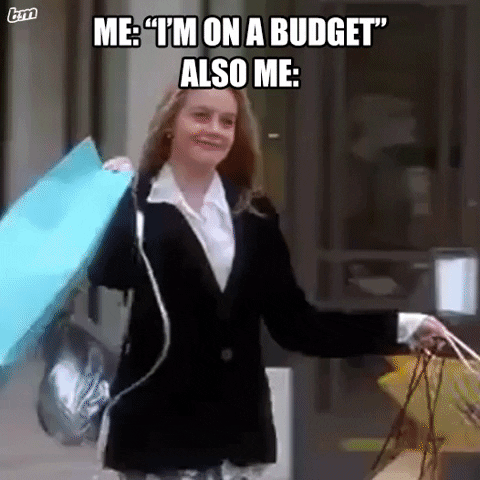 Giphy
GiphyOkay, so I read that last year, 36 percent of Americans incurred some type of holiday-related debt. Hmph. Last year, there was still some sense of normalcy in this country, chile, so I can only imagine what finances are gonna look like over the next several weeks. That said, since I don’t know a lot of people who don’t find being broke stressful, make sure that you and your bae set a budget and then stick to it this year — no ifs, ands or buts.
Because really, y’all — it doesn’t make sense to deplete savings and/or max out credit cards for a few days of giggles only to be damn near losing your mind because you don’t know how to make ends meet come Dr. Martin Luther King, Jr. Day.
And by the way, this tip doesn’t just speak to things like food and gifts; I also mean travel. If it doesn’t make a ton of sense (or cents) to be all over the place this year — DON’T BE.
Keep Matthew 5:37 at the Forefront
 Giphy
GiphyIf off the top of your head, you don’t know what Matthew 5:37 says, no worries, here ya go: “But let your ‘Yes’ be ‘Yes,’ and your ‘No,’ ‘No.’ For whatever is more than these is from the evil one.” That verse right there? Oh, it’s a boundaries lifesaver! I say that because do you see “maybe” or “I’ll think about it” in there? Nope. LOL. It says that you should tell people “yes” or “no” and leave it at that — and that complements Anne Lamott’s quote, “’No’ is a complete sentence” impeccably well. Yeah, you’ve got to remember that anything beyond a yes or no to a request is privileged information; you don’t owe anyone details or an explanation.
Besides, if you are really honest with yourself, when someone asks you something and you give a “Umm, let me think about it” kind of reply, more times than not, you already know what your answer is going to be — so why not let you both off of the hook? Give your response. Commit to that. And let everyone (including yourself) get on with their lives and schedules.
I promise you that when it comes to those holiday parties, you are pissing more folks off by not RSVP’ing or doing so and not showing up than just saying, “Thank you but not this year” off the rip.
Remember That Your Personal Space Is Privilege Not a Right
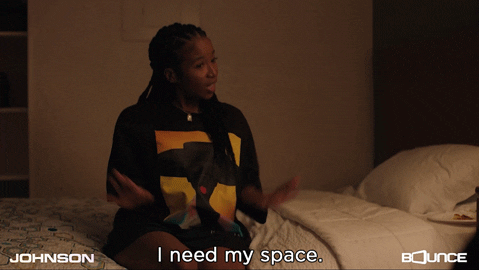 Giphy
GiphyA friend of mine recently bought a new house and invited me over to come see it. He’s a single man with no children, so as I was taking in all of the space that he had, especially as I walked through his finished basement, I joked about relatives coming to live with him. “Hell no” and “absolutely not” were pretty much his immediate responses as he went on to say that some folks even had the nerve to be offended when he told them that he had no intentions on taking DNA in.
Ain’t it wild how people think that your stuff is their right? And yes, that brings me to my next point. Your home is your sanctuary space. If you want to host folks this year — cool. If not, ALSO COOL. Please don’t let folks (family included) guilt you into how they want you to act or even into what they would do if the shoe was on the other foot. You are not them — and as one of my favorite quotes states, “If two people were exactly alike, one of them would be unnecessary.” (A man by the name Larry Dixon said that.)
Hell, my friends? They know that I am good for sending them random things that they need or even want all throughout the year. Coming over to hang out at my pace, though. Uh-uh. Chalk it up to being a card-carrying member of the ambivert club yet I like keeping my living space personal — and I sleep like a baby, each and every night, for feeling that way.
Always remember that your space, your time, your resources, your energy and shoot, yourself period (including your relationship), are all things that are your own. You get to choose how, when and why you want to share them. The holiday season is certainly no exception.
Cultivate Some “You Two Only” Traditions
 Giphy
GiphyIt’s not uncommon for some couples to hit me up after the holiday season to “detox.” Sometimes it’s due to the financial drama (and sometimes trauma) that they experienced. Sometimes it’s because they allowed their relatives (especially in-laws) to get more into their personal business than they should’ve. More than anything, though, it tends to be because they didn’t get enough quality time together and so ended up feeling “disconnected.”
Please don’t let that happen. Listen, I’m not even a holidays kind of woman and yet, I will absolutely sit myself down with some hot chocolate and chocolate chip cookies to enjoy a Hallmark holiday film or two. Aside from the fact that most of them are lighthearted and sweet, I also like that they usually focus on couples loving on each other amidst all of the holiday beauty and ambiance — which is something that all couples should set aside some time to do.
Maybe it’s a vacation. Maybe it’s a staycation. Or maybe it’s my personal favorite, A SEXCATION. Whether it’s for a few days, the weekend or even overnight — don’t you let the holidays go by without setting aside time for you and your man to celebrate one another. Don’t you dare (check out “Are You Ready To Have Some Very Merry 'Christmas Sex'?”).
GET. SOME. REST.
 Giphy
GiphyI once read that 8 out of 10 people get stressed out over the holidays and 3 out of 10 lose sleep during to it — and when you’re stress-filled and sleep-deprived, that can absolutely lead to hypersensitivity, making mountains out of molehills and even not being in the mood for sex.
Your relationship can’t afford to go through any of this, so definitely make sure to prioritize rest. I don’t care how unrealistic it might seem during this time, sleep should never be seen as a luxury; it will always and forever be a great necessity.
That said, try to get no less than six hours of shut-eye in (check out “6 Fascinating Ways Sex And Sleep Definitely Go Hand In Hand”) and even ask your bae to take a nap with you sometimes (check out “Wanna Have Some Next-Level Sex? Take A Nap, Sis.”). Not only will sleep help to restore your mind, body and spirit but, when it’s with your partner, it’s an act of intimacy that can make you both feel super connected, even in the midst of what might feel like chaos.
___
Holiday season stress is real. Still, never give it the permission or power to throw your relationship off. Put you and your man first and let the holidays be what they are gonna be, chile.
Let’s make things inbox official! Sign up for the xoNecole newsletter for love, wellness, career, and exclusive content delivered straight to your inbox.
Featured image by Shutterstock
Sergio Hudson On Designing With Intention And Who Gets Left Out Of The Industry
Sergio Hudson dreamt big as a young South Carolina boy staring out of the window of his mom’s Volvo driving down the Ridgeway, South Carolina streets. Those dreams led him to design opulent tailoring that’s been worn by Beyoncé, Queen Latifah, former Vice President Kamala Harris and Forever First Lady Michelle Obama, just to name a few.
Those dreams have come full circle in a new way as he recently collaborated with Volvo for a mini capsule collection suitable for chic and stylish moments this fall. The 40-year-old designer follows a long legacy of fashion aficionados who’ve used their innovation to push the automotive industry forward, including Virgil Abloh, Eddie Bauer, Paul Smith and Jeremy Scott.
Using the same material from the interior of the Volvo EX90, Hudson crafted a wool-blend car coat and waistbelt that combine the vehicle’s Scandinavian design with his signature tailoring and intention. The exclusive collection launched on October 20, and each piece is made-to-order by Sergio Hudson Collections.

Courtesy
In October, I traveled to Charleston with a group of journalists to get a firsthand look at Hudson and Volvo’s location. During a fitting, Hudson said his goal is to make “great work that can stand the test of time.”
“People can look back on and say, ‘I remember when Sergio did that collaboration with Volvo,’” he continued. “Thinking about aligning yourself with classic brands that speak to where you want to go. And I think that's what this collaboration kind of means to me and my business.”
Hudson pinpoints his mom as the biggest influence for his designs. This collaboration was no different.
“This particular coat reminded me of the swing coats that my mom used to wear in the early 90s. You know, diva girls in the early 90s had Sandra suits,” he said, referring to Jackée Harry’s character in 227. “My mom wore those and she would have these matching swing coats to go over them. And that's where the initial idea came. This would be around the same time that we had our Volvo. So she would put on her suit, her swing coat, get in that red Volvo, and go to church.”
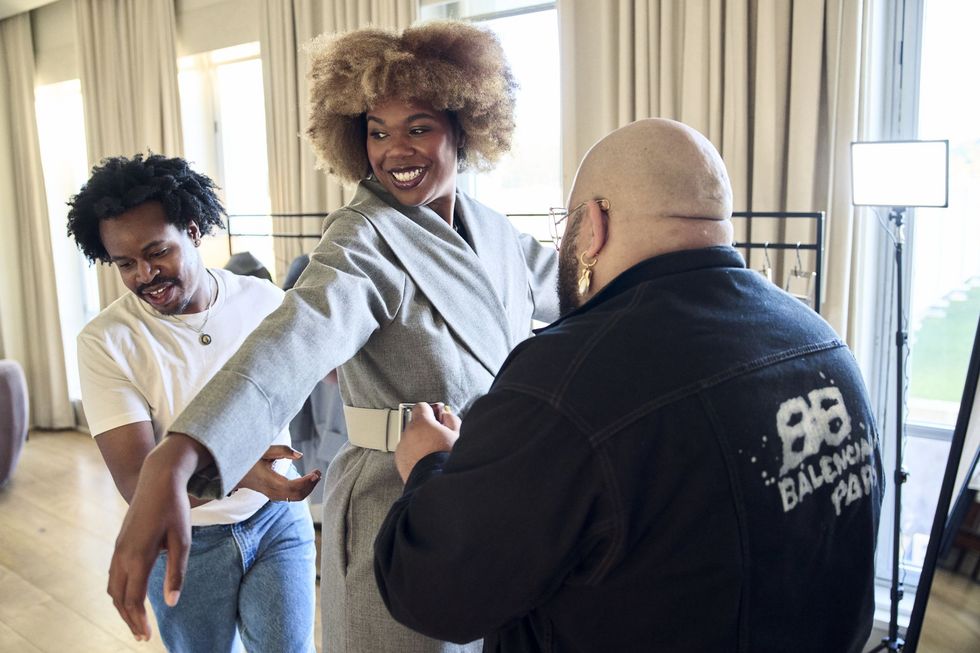
Courtesy
With this capsule and beyond, Hudson wants to see more staples rotating in and out of closets this fall. He advises fashionistas to build her closet out with essentials to mix and match that aren’t just stylish but also sustainable.
“It's just those special pieces,” he said. “You can wear the same shirt and pants every day and nobody will notice. But if you have a special boot, a special coat, a special bill, a special bag, that kind of speaks to everything that your style stands about, that is something you should focus on.”
These are the same kind of staple pieces that return to our Pinterest boards and TikTok feeds season after season. Fast fashion has never been Hudson’s aim. “I'm trying to create a special pieces that can stand the test of time,” he said in his warm, Southern accent. “I'm only creating those kind of pieces from here on out.”
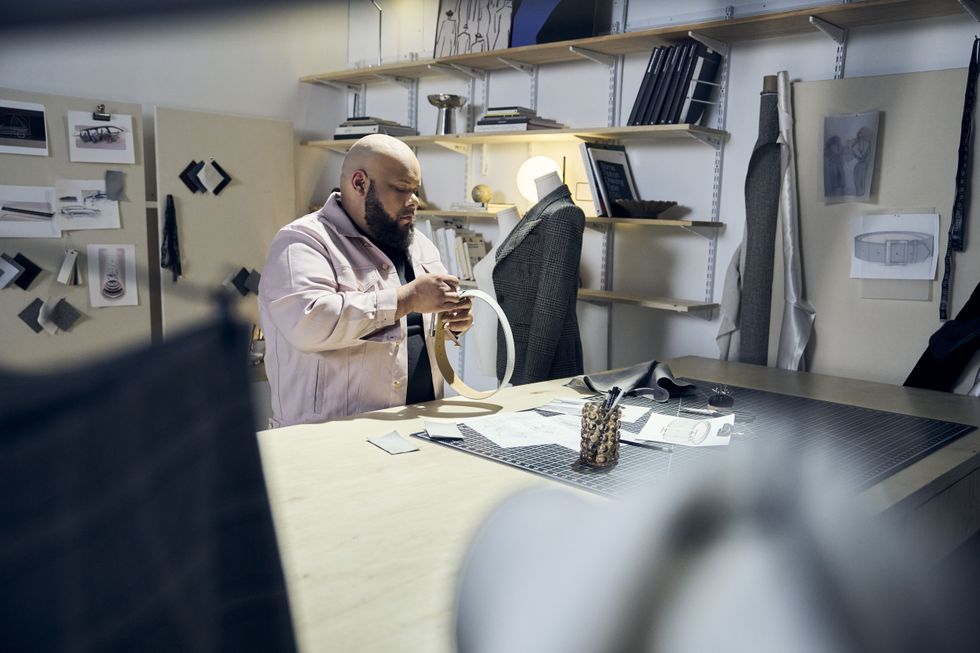
Courtesy
For Hudson, this collaboration is revolutionary. It’s his first time working with a car company and experimenting outside of his wheelhouse in this way.
“This is a Scandinavian brand, and, you know, it's 70 years old. I'm an African-American boy from South Carolina that has had a brand for 10 years. So I think bridging those two worlds and seeing the similarities was the beauty of this project,” he explained.
Though Hudson and his partner and CEO of Sergio Hudson Collections Inga Beckham have made massive strides in just 10 years, Hudson said the industry is far from where he wants to see it when it comes to Black representation. He pointed to how few Black designers were at this year’s Met Gala despite the theme being Black dandyism.
“The fact that I dressed 18 people speaks to how many of us weren't there,” he said. He implored more of industries, fashion and beyond, to collaborate with Black designers often.
“Allow mentorship. Allow funding. Allow great design to shine through,” he implored. “When it comes to being a designer of African descent, when you can't get the funding that your counterparts have, you can't compete. When you get opportunities like doing a collaboration with Volvo, or you get opportunities to be at the Met Gala, that's putting us on the equal playing field, but really the funding behind it is what we need to take it to that desk level.”
Featured image courtesy



